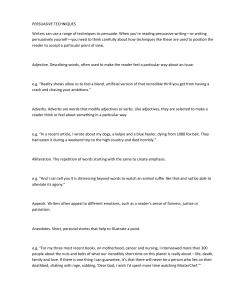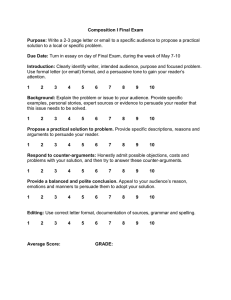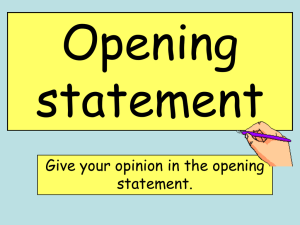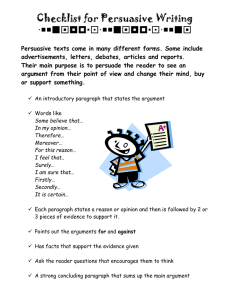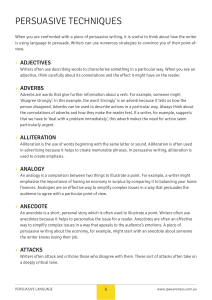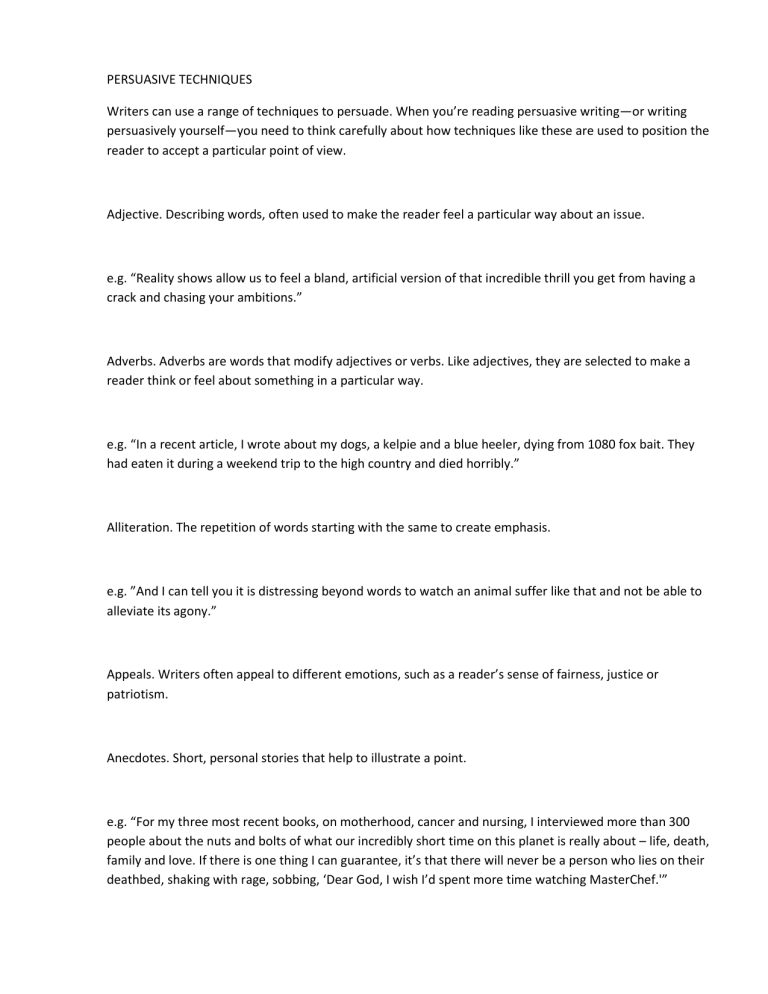
PERSUASIVE TECHNIQUES Writers can use a range of techniques to persuade. When you’re reading persuasive writing—or writing persuasively yourself—you need to think carefully about how techniques like these are used to position the reader to accept a particular point of view. Adjective. Describing words, often used to make the reader feel a particular way about an issue. e.g. “Reality shows allow us to feel a bland, artificial version of that incredible thrill you get from having a crack and chasing your ambitions.” Adverbs. Adverbs are words that modify adjectives or verbs. Like adjectives, they are selected to make a reader think or feel about something in a particular way. e.g. “In a recent article, I wrote about my dogs, a kelpie and a blue heeler, dying from 1080 fox bait. They had eaten it during a weekend trip to the high country and died horribly.” Alliteration. The repetition of words starting with the same to create emphasis. e.g. ”And I can tell you it is distressing beyond words to watch an animal suffer like that and not be able to alleviate its agony.” Appeals. Writers often appeal to different emotions, such as a reader’s sense of fairness, justice or patriotism. Anecdotes. Short, personal stories that help to illustrate a point. e.g. “For my three most recent books, on motherhood, cancer and nursing, I interviewed more than 300 people about the nuts and bolts of what our incredibly short time on this planet is really about – life, death, family and love. If there is one thing I can guarantee, it’s that there will never be a person who lies on their deathbed, shaking with rage, sobbing, ‘Dear God, I wish I’d spent more time watching MasterChef.'” Everyday language. Writers will often use everyday language, sometimes called colloquial language, to make themselves seem down-to-earth. e.g. “Fairness is the cornerstone of our constitution and our national identity. But as we head into an election year, I think we need to ask ourselves whether we really believe in a fair go for all.” Cliches. An overused expression. Although they should be avoided, cliches give writers an opportunity to express an idea to their readers quickly. Here are some examples of cliches: • Absence makes the heart grow fonder. • Alls well that ends well. • As light as a feather. • Time will tell. Connotations. All words have connotations or associations. Some words, for example, may have the same literal meaning but very different connotations. Connotations may be negative or positive. Think about the word ‘thin’. There are lots of words that share this meaning—slender, lithe, slim, skinny, lean, slight, lanky, undernourished, wasted, gangly, rake-like, anorexic, spindly. If someone was describing your body, you would probably prefer to be called ‘slender’ or ‘slim’ rather than ‘lanky’ or ‘anorexic’. When people are writing an argument, they think very carefully about the words that they select and the impact these words will have on their audience. Emotive words. Words that provoke an emotional reaction from the audience. e.g. “But no, people from the bush were saying it is cruel to kill foxes with a poison that causes a slow, agonising death.” Exaggeration. Writers often exaggerate or overstate something to help persuade readers of their point of view. e.g. “Our experts will tell you a million reasons why it can’t or shouldn’t be done here. They have turned excuse-making into an art form.” Evidence. Writers will often use evidence – which might take the form of facts, figures, quotes or graphs – to help support their argument. e.g. “According to the Australian Bureau of Statistics, males are 400 per cent more likely to commit an offence intended to cause injury than are females.” Expert opinion. Sometimes writers will use the opinion of experts to give further weight to their argument. e.g. “A new research report by Victorian doctors illustrates why: because when kids are worried their parents will be told their private medical details, they simply don’t go to the doctor.” Inclusive language. Inclusive language – using the words ‘we’ or ‘us’ – is often used to get a reader onside. e.g. “We might not like it, but our kids’ right to confidential medical advice should take precedence over our right to know about it.” Imagery. Descriptive writing can be a powerful persuasive technique. Describing something vividly can persuade readers. Logic. A logical, well-structured argument can be very persuasive. Metaphor. Metaphors, when one thing is described as another, help to persuade by describing. e.g. “I’ve been dying of it all week and can hardly type this column because of the Niagra of snot pouring down my face and the painful fires of a thousand suns burning in my joints and muscles, which being manly muscles are able to carry a much heavier load of pain than lady muscles.” Pun. A play on words often relying on homophones, homonyms or rhymes. e.g. “It’s been a trying year for rugby league, what with betting scandals, controversies over players’ alleged off-field behaviour and an unseemly on-field brawl that marred the sport’s reputation on approach to the finals.” e.g. “Racism is no black and white issue”. Repetition. The repetition of words, phrases and ideas can be used to reinforce an argument and drive home the message to a reader. e.g “It has been well established here and overseas that if teenagers think they can see a doctor in confidence, they are more likely to do so, more likely to go back for repeat visits, and more likely to disclose sensitive information.” Rhetorical question. A question where the answer is obvious, can help lead readers to a particular conclusion. e.g. “It has been well established here and overseas that if teenagers think they can see a doctor in confidence, they are more likely to do so, more likely to go back for repeat visits, and more likely to disclose sensitive information. And isn’t this the outcome we want? ” Sarcasm. A mocking tone. e.g. “Not all of us can write Max Walker’s How to Hypnotise Chooks, you know – for many years the biggest-selling title in Australian literary history.” Simile. Similes, when one thing is compared to another, can help to persuade by describing. e.g. “…as dumb as a sack of hammers…” Tone. The tone of an article or speech refers to its overall feeling. Is it passionate? Logical? Reasonable? Mocking? Humorous?
